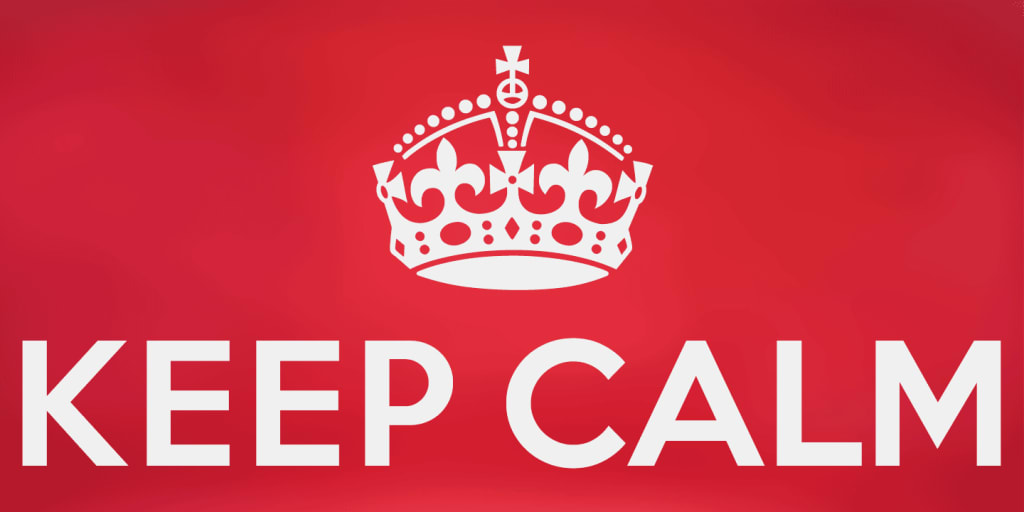"Keep Calm Richard"
One Man and His Keyring

While I was out and about recently, I bought a keyring from a gift shop marked with the words "Keep Calm Richard." Obviously, this is a very generic keyring. One of many to use an adaptation of the WWII slogan "Keep Calm and Carry On" with any numbers of names or titles underneath. Given that I have been at a low ebb recently and wrestling with my health, it seemed like something I should get myself as a poignant reminder to relax. The dark green background clinched it for me—being one of my favourite colours.
As I’ve studied it, I have started to ponder each of these words individually. Let’s see if we can’t break it down. First of all, as I mentioned, my name in this situation is completely interchangeable with anyone else’s. In fact, I saw keyrings saying "Keep Calm Mum" or "Keep Calm Nan" so my name is the portion that could be easily removed. Though I would like to share with you a riddle that I remember from my childhood. Maybe you remember the same one.
What belongs to you but is used more by other people? Your name.
Seeing my name on my keyring is of course another constant reminder, this time that of my own importance and the priority I should give myself. Think about that the next time you see a pen, mug, keyring, mouse mat, magnet—and yes, keyring—with your name on it.
Next, Calm.
A widespread word. The name of CALM (Campaign for Living Miserably) the first hotline I contacted when I was faced with my own depression. 1000s of books exist with the word "calm" on the front cover, and even more exist with the word contained in their pages. You may also use the word a lot if you practice the frequent imitation of a Liverpudlian accent.
We tell others to calm down. Perhaps more than ourselves. Perhaps because they’re being anxious. Or aggressive. Or we don’t. Because they’re being too aggressive and we don’t want to rock the boat. I know this has happened to me before. I’ve turned the other cheek when I could have said or done something that perhaps my natural impulses would have wanted me to do. In the short, I know that this can cause some worry and discomfort around these people but in the end, it is the right thing to do.
We are told to be calm. Or "Relax" or "Don’t worry" are perhaps more common expressions. And sometimes it can be hard to listen fully and rationally to those who tell you this. Because I for one find that I cannot help it. I will worry when there appears to be nothing to worry about. I will worry first sand tell myself not to do so afterwards. Sometimes long afterwards by which stage I have to calm down or I run the risk of a heart attack.
Which brings me onto Keep. Getting to calm in the first place is a challenge, but staying there and keeping that mindset is perhaps the hardest thing. Something will come along to drag you out of it. Some worry you’ll have about being late somewhere. Or about having not done enough work. The smallest thing can trigger a bad mood, even if you don’t expect it to. And even if you tell yourself not to let it get to you, it marinates in your mind cauldron, and you can find that even if you’ve had a good day still you can’t wait for it to be over.
So just how do I interpret this word? Keep. Well this is how I fear it works; not until I get wound up or start to get wound up, or at the very earliest feel I might get wound up in the next few minutes if I don’t take action—do I then take that action and be calm.
Action could be a vast variety of things. I haven’t used candles for some time, but I do have a wax melt that I keep on my desk that I inhale the aroma of fairly periodically, and I have some vanilla scented room spray.
Action could be do whatever I am doing at a slow, deliberate pace. Close doors behind me with much less noise. Write slower. Something I am doing at this very second as I type out this sentence you are reading. Drink slower. Eat slower.
I am a very big advocate for mindfulness. I do yoga every morning (with rare exception) and meditate most evenings. For each of these activities I clear the time exclusively. Usually my yoga in the mornings lasts around 15 minutes—sometimes 20 on weekends— and my meditation session lasts around 5–10. Yoga focuses my attention on my body and my posture. Meditation focuses more on my breathing and my stillness. Both of them allow me appreciate and focus on my surroundings (sometimes even with me staring at a "focus spot" as I call it).
Mindfulness actually extends beyond these activities, and that’s what I feel people unfamiliar with mindfulness would not know. Setting aside the above times for meditation and yoga might sound like a lot to some people. And when I consider that you would be doing nothing except breathing, something you do all the time and remaining quiet and still. You’re doing nothing, which though the point, doesn’t appeal to everyone.
However, I can tell you with these few pages how you can and perhaps do practice mindfulness without even knowing it. I believe it can link in no small parts to little trinkets like the keyring that inspired this post. I have trinkets on display in my room in Salisbury and at my room in Sheffield. Probably too many to mention. Almost all of them music related, some of them (a wooden duck whistle, a "croaking frog" guiro) fulfilling an actual music function.
Every possession we have tells a story, so it’s not worth me telling all of them here. Being mindful is all about being present in the moment and not agonising about the past and worrying about the future and the smallest of things can help achieve it. Family photos, like the one I have from a holiday in 2012. Cards or handwritten post-it note with inspirational quotes or bits of advice. These are what you may refer as mantras and bear repeating throughout the day.
If my inspirational advice for the day (either taken from my Mindfulness book or recommended to me by the Headspace app) is to be aware of the smells surrounding me, I obviously won’t be doing this every second of the day. But the card or post-it note can quite easily bring me back.
Another thing I often do is to read about how the rest of the world practice mindfulness, and indeed see the world they make up. I have read varying amounts at various times about:
- Hygge: The Danish way of living comfortably
- Lakom: A Swedish word meaning “just the right amount”
- Sisu: The Finnish art of courage
- Ikigai: A Japanese concept meaning “a reason for being”
These are definitely countries I would be interested in visiting perhaps more so now that I know mindfulness related concepts are embracing there. Blake D. Bauer’s You Were Not Born to Suffer has a section arguing that we all neglect selfishness as a necessary, common and even positive emotion, and should accept that we will naturally one to look after number one.
Linking all of this back to the keyring, I believe we can all practice mindful by having to hand those things that keep it most mindful. And weirdly enough, yes, they do relate to a physical possession of some kind. But the greatest you possess are inside and can quite easily by brought out just by looking and listening around you.
So Keep Calm. Whoever you are.
About the Creator
Richard Brind
Musician/ Music Techie. Contributing to the BEAT sub-feed of VOCAL. I'd like to think I have something to say about Music and pop culture.
PSYCHE/MOTIVATION contributions possible too.
Social Media: https://www.instagram.com/bigbadbrind/






Comments
There are no comments for this story
Be the first to respond and start the conversation.